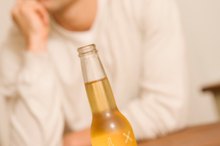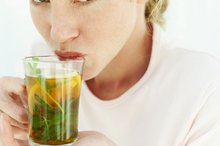What does fact checked mean?
At Healthfully, we strive to deliver objective content that is accurate and up-to-date. Our team periodically reviews articles in order to ensure content quality. The sources cited below consist of evidence from peer-reviewed journals, prominent medical organizations, academic associations, and government data.
The information contained on this site is for informational purposes only, and should not be used as a substitute for the advice of a professional health care provider. Please check with the appropriate physician regarding health questions and concerns. Although we strive to deliver accurate and up-to-date information, no guarantee to that effect is made.
Why Does Alcohol Cause a Puffy Face?
Facial swelling or facial edema, occurs when fluid builds up in the tissues of the face, according to the National Institutes of Health 4. Possible causes include allergic reaction, infection, drug reactions and injury. Another possible cause is the over-consumption of alcohol, Alcohol Advisory Council of New Zealand (ALAC).
If you are experiencing serious medical symptoms, seek emergency treatment immediately.
Dehydration
When dehydrated, the body will compensate by retaining water, which results in enlarged blood vessels and bloating. Alcohol halts the production of an anti-diuretic hormone, causing the body to lose water and essential vitamins through excessive urination, according to the ALAC. Because alcohol dehydrates the body, it can cause water retention and puffiness of the face and body.
Long-Term Excessive Consumption
Effects of Alcohol on Skin
Learn More
Excessive alcohol consumption is defined as more than two drinks per day for men, and more than one drink a day for women, according to the Centers for Disease Control (CDC) 3.
The study cites a case of a man with massively swollen eyes and upper lip, most likely due to a decade of excessive alcohol consumption.
Binge Drinking
Binge drinking is defined by the CDC as heavy consumption of alcohol within a short period of time—five or more drinks in a row by men and four or more by women on at least one occasion in two weeks. A puffy face may occur from binge drinking as a result of a variety of causes: chronic dehydration, vitamin deficiency or hypersensitivity.
An article in the UK Daily Mail describes a BBC filmmaker who, as an experiment, went binge drinking five nights a week for a month. As a result, she lost her jaw line, developed “chipmunk cheeks” and belly fat. She was able to feel “normal” and healthy again a couple of months after she stopped binge drinking.
- Binge drinking is defined by the CDC as heavy consumption of alcohol within a short period of time—five or more drinks in a row by men and four or more by women on at least one occasion in two weeks.
Alcohol Flush Reaction
Facial Skin Problems Related to Alcohol
Learn More
Even those who consume alcohol in moderation may experience a puffy face. Alcohol flush reaction is an allergic reaction to alcohol characterized by nausea, rapid heartbeat and a red, swollen face, according to CNN Health 4.
The allergy is caused by an inherited enzyme deficiency common among East Asians. The enzyme, known as ALDH2, metabolizes alcohol into acetate.
- Even those who consume alcohol in moderation may experience a puffy face.
- The allergy is caused by an inherited enzyme deficiency common among East Asians.
TIps
Drink in moderation to avoid a puffy face and other effects of alcohol over-consumption. Avoid binge drinking by staggering drinks over the course of several hours. Drink on a full stomach and ingest plenty of water to compensate for dehydration. If you have an alcohol flush reaction it's probably best to stop drinking alcohol.
- Drink in moderation to avoid a puffy face and other effects of alcohol over-consumption.
Related Articles
References
- NLM & NIH MedLine Plus: Facial swelling
- Alcohol-related massive eyelid swelling: case report
- Centers fo Disease Control: Alcohol
- CNN Health: Why the red face?
- Claridge LC. Drugs and harm to society. The Lancet. 2011;37(9765):552. doi:10.1016/S0140-6736(11)60194-3
- National Institute on Alcohol Abuse and Alcoholism. Drinking Levels Defined.
- Centers for Disease Control and Prevention. Binge drinking is a serious but preventable public health problem. Updated December 30, 2019.
- Maimaris W, Mccambridge J. Age of first drinking and adult alcohol problems: systematic review of prospective cohort studies. J Epidemiol Community Health. 2014;68(3):268-74. doi:10.1136/jech-2013-203402
- Arain M, Haque M, Johal L, et al. Maturation of the adolescent brain. Neuropsychiatr Dis Treat. 2013;9:449-61. doi:10.2147/NDT.S39776
- Dang JN. Washington, DC: U.S. Department of Transportation - National Highway Traffic Safety Administration technical report. Statistical analysis of alcohol-related driving trends, 1982-2005. 2008.
- U.S. Department of Transportation National Highway Traffic Safety Administration. Results of the 2013–2014 National Roadside Survey of Alcohol and Drug Use by Drivers. Traffic Safety Facts. February 2015.
- Fell JC, Voas RB. The effectiveness of a 0.05 blood alcohol concentration (BAC) limit for driving in the United States. Addiction. 2014;109(6):869-74. doi:10.1111/add.12365
- Agius P, Taft A, Hemphill S, Toumbourou J, Mcmorris B. Excessive alcohol use and its association with risky sexual behaviour: a cross-sectional analysis of data from Victorian secondary school students. Aust N Z J Public Health. 2013;37(1):76-82. doi:10.1111/1753-6405.12014
- National Institute on Alcohol Abuse and Alcoholism. College Drinking. Updated February 2020.
- Thomas S. American Addiction Centers. The Effects of Alcohol on the Body. October 24, 2019.
- Centers for Disease Control and Prevention. Alcohol and Cancer. July 8, 2019.
- Mirijello A, D'angelo C, Ferrulli A, et al. Identification and management of alcohol withdrawal syndrome. Drugs. 2015;75(4):353-65. doi:10.1007/s40265-015-0358-1
- Centers for Disease Control and Prevention. Vital Signs: Alcohol Poisoning Deaths — United States, 2010–2012. January 2015.
- National Institute on Alcohol Abuse and Alcoholism. Understanding the Dangers of Alcohol Overdose.
- Gudin JA, Mogali S, Jones JD, Comer SD. Risks, management, and monitoring of combination opioid, benzodiazepines, and/or alcohol use. Postgrad Med. 2013;125(4):115-30. doi:10.3810/pgm.2013.07.2684
- Melemis SM. Relapse Prevention and the Five Rules of Recovery. Yale J Biol Med. 2015;88(3):325-32.
Writer Bio
Angela Tung has been writing professionally for more than 15 years, working in such fields as publishing and marketing, with work appearing in "New York Press" and "Carve Magazine." Her YA novel, "Song of the Stranger," was published by Roxbury Park Books. She has a M.A. in creative writing from Boston University and an M.S. in library science from the Pratt Institute.









